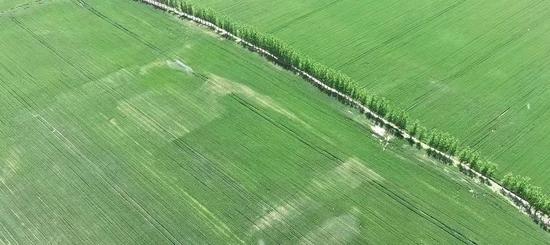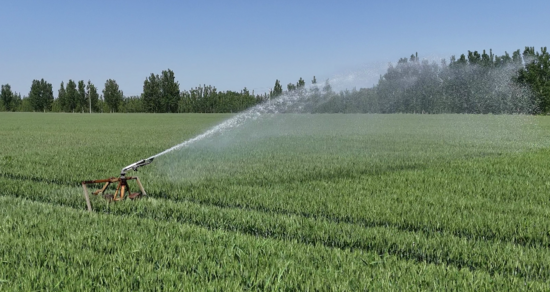Here we are taking action to fight drought and protect irrigation
Since the first ten days of March, rainfall across Henan Province has been less than normal. Coupled with the continuous high temperatures, soil moisture loss has accelerated, and various regions have successively experienced varying degrees of drought, which has brought adverse effects to agricultural production and people's lives.
The Department of Water Resources of Henan Province has earnestly implemented the important instructions of the General Secretary on flood control and drought relief work. In accordance with the work arrangements of the provincial Party committee and the provincial government, it adheres to the people-centered ideology, focuses on ensuring national food security, and takes drought relief to guarantee irrigation, water supply and people's livelihood as the top priority at present.

The spring irrigation work in the Sanyizhai Irrigation District of Henan Province is proceeding in an orderly manner.
Since April 19th, the Water Resources Department of Henan Province has activated the mechanism for flood and drought disaster prevention and control, concentrating human and material resources, taking proactive actions, guiding the provincial water resources system to implement and refine drought relief measures, and doing its utmost to transport water as far as possible to provide strong water resources support for "not missing the farming season and irrigating according to the land conditions".
Make timely arrangements and deployments
Keep a close eye on the development trend of drought conditions, and in combination with medium and long-term weather forecasts, remind all regions in early April to pay attention to changes in soil moisture and make preparations for drought resistance. On April 11th, the "Notice of the Henan Provincial Department of Water Resources on Doing a Good Job in Current Drought Relief Work" was issued, organizing water conservancy departments at all levels to do a good job in the current drought relief and irrigation protection work throughout the province. A provincial meeting on flood and drought prevention and control was held on April 15th. Special meetings were held on April 19th and 24th to analyze and assess the drought relief situation and make arrangements for drought relief work.
Strengthen the monitoring of drought conditions
Continuously monitor the rainfall and soil moisture conditions as well as the development of drought, increase the frequency of monitoring, and dynamically grasp the water storage, water discharge, water supply and groundwater storage variables of water conservancy projects throughout the province. Organize two drought relief consultations every week and make dynamic adjustments based on the development of drought. Strengthen communication with departments such as meteorology, agriculture and emergency management, conduct in-depth analysis of the impact of drought on agricultural production and people's drinking water, and make targeted arrangements and deployments for drought resistance work.
Scientific scheduling of water sources
Adhere to the principle of "carefully calculating and making good use of water resources, and strictly and meticulously managing water resources", and scientifically schedule various water projects. Since the drought occurred, we have been closely monitoring the demand for irrigation water, coordinating lakes, ponds, DAMS, rivers and canals, and timely dispatching large and medium-sized reservoirs. We have precisely, meticulously and precisely adjusted the discharge flow of large and medium-sized reservoirs such as Yahekou, Zhaopingtai, Baigui Mountain and Suyahu Lake. Since March, the total discharge volume of large and medium-sized reservoirs under the provincial jurisdiction has reached 1.202 billion cubic meters. In response to the water demand in the areas along the Yellow River, we actively requested the Yellow River Conservancy Commission to increase the discharge capacity of Xiaolangdi and Xixiayuan Reservoirs to support drought relief efforts throughout the province.
The Xiaolangdi Reservoir has increased its discharge to support irrigation in the areas along the Yellow River
Ensure irrigation water supply
Give full play to the drought resistance role of large and medium-sized irrigation districts, dynamically grasp the water demand of the sown crops during their growth period and the water shortage, available water volume and expected water inflow of the crops to be sown, precisely match the water demand period and water volume of the crops, and meticulously dispatch water source projects such as reservoirs, pumping stations and sluice gates. As of early May, 235 large and medium-sized irrigation districts across the province had opened sluice gates to draw water, with a total of 2.392 billion cubic meters of water drawn. The cumulative irrigated area was 18.4344 million mu, and the supplementary source area was 3.079 million mu.

Ensure the safety of human drinking
Conduct dynamic investigations and accurately grasp the situation of drinking water difficulties faced by rural residents. Formulate and improve water supply guarantee plans, with a focus on remote mountainous areas and regions not covered by centralized water supply projects. Ensure that no household or individual is left behind to guarantee the safety of drinking water for the people. Effective measures have been taken to solve the water supply problem for over 600 people in two villages, namely Shanyuan and Fenwa, in the Jiyuan Demonstration Zone.
Strengthen financial guarantee
Based on the provincial drought relief water source guarantee situation, in conjunction with the Department of Finance, 10 million yuan of provincial water conservancy disaster relief funds (drought relief) for 2025 will be allocated to support the work in drought-stricken areas. The "Notice on Reporting the Performance Targets of Provincial Water Conservancy Disaster Relief Funds (Drought Relief) for 2025" was issued to further urge all provincial cities to accelerate project implementation and strengthen performance monitoring.





